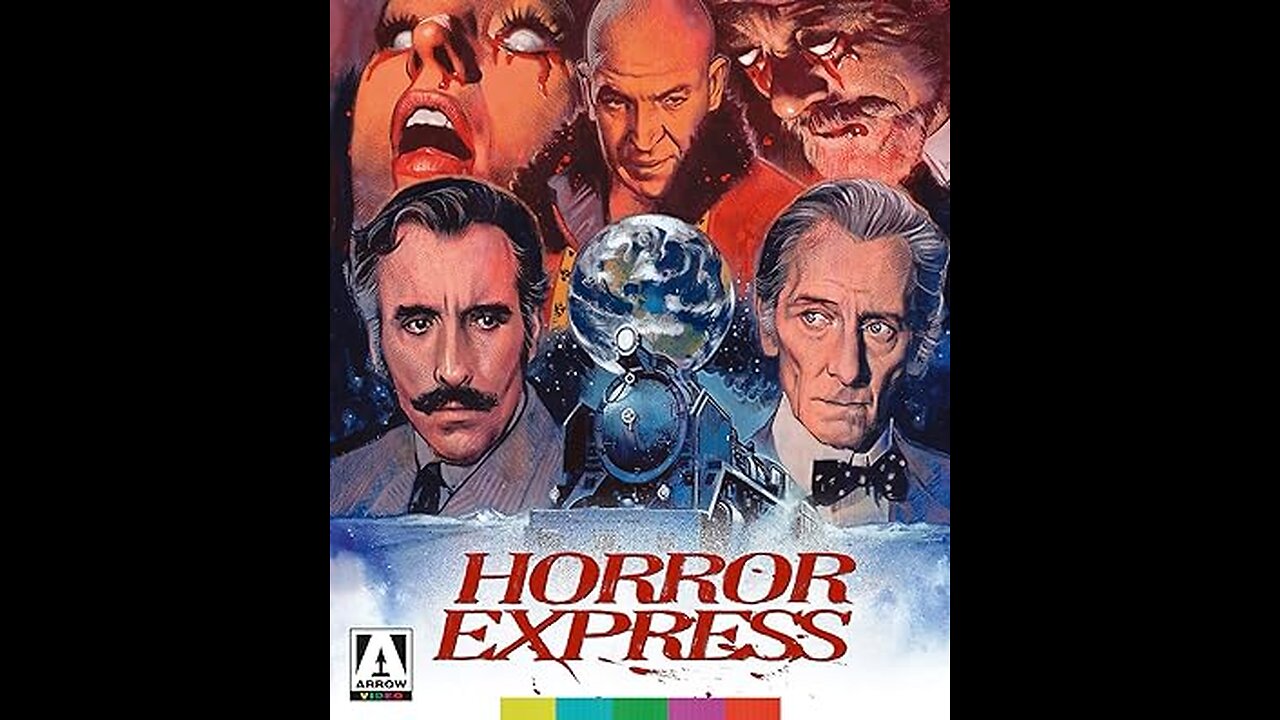Premium Only Content

HORROR EXPRESS (1972).
HORROR EXPRESS (Spanish: Pánico en el Transiberiano, lit. "Panic on the Trans-Siberian") is a 1972 science fiction horror film directed by Eugenio Martín. It is a loose adaptation of John W. Campbell's 1938 novella Who Goes There?, and stars Christopher Lee and Peter Cushing, with Alberto de Mendoza, Silvia Tortosa, Julio Peña, George Rigaud, Ángel del Pozo, and Telly Savalas in supporting roles.
Set in 1906, the film's storyline follows the various passengers aboard a European-bound Trans-Siberian Railway train. They are soon stalked, one by one, by an alien intelligence inhabiting the frozen body of an ancient primitive humanoid brought on board by an anthropologist.
PLOT
In 1906, Professor Sir Alexander Saxton, a British anthropologist, is returning to Europe by the Trans-Siberian Express from Shanghai to Moscow. With him is a crate containing the frozen remains of a primitive humanoid that he discovered in a cave in Manchuria. He hopes that it is a missing link in human evolution. Doctor Wells, Saxton's friendly rival and Geological Society colleague, is also waiting to board. Also waiting is Polish Count Marion Petrovski and his wife, Countess Irina. With the couple is their spiritual advisor, an Eastern Orthodox monk named Father Pujardov, who proclaims to Saxton that the contents of the crate are evil. Additional passengers include Inspector Mirov and a squad of soldiers.
Saxton‘s eagerness to keep his scientific findings secret arouses the suspicion of Wells, who bribes a porter to investigate the crate. The porter is killed by the defrosted humanoid within, who escaped the crate after picking the lock and kills several more passengers. Wells performs an autopsy and deduces that the creature absorbs the skills and memories of its victims. When the humanoid is gunned down by Mirov, the threat seems to have been eliminated. Saxton and Wells discover that the real threat is a formless extra-terrestrial that inhabited the body of the humanoid. Unknown to them, the creature has transferred itself into Mirov.
The extra-terrestrial has been stranded on Earth for millions of years. It kills passengers with specific knowledge that could help it build a new spaceship. Eventually, Cossack Captain Kazan stabs and shoots Mirov. With Mirov dying, Pujardov, believing the creature to be Satan and having pledged allegiance to it prior, allows it to possess him. The passengers flee to the brake van while the alien murders Kazan, his men, and the Count. Saxton, having discovered the creature cannot use its powers when it is exposed to light, blinds it. The alien bargains with Saxton, tempting him with its advanced knowledge of technology and cures for diseases. When Saxton refuses, it resurrects all its victims as zombies, and has them attack Saxton.
Saxton and the countess fight their way through the train until they reach the van, where the other survivors have taken refuge. Saxton and Wells uncouple the van from the rest of the train containing the alien. Kazan's superiors send a telegram to a dispatch station ahead, instructing them to destroy the train by sending it down a siding overlooking a gorge. The survivors watch as the train crashes down the gorge and goes up in flames.
CAST
Christopher Lee as Professor Sir Alexander Saxton
Peter Cushing as Dr. Wells
Alberto de Mendoza as Father Pujardov (dubbed by Robert Rietti)
Silvia Tortosa as Countess Irina Petrovski (dubbed by Olive Gregg)
Julio Peña as Inspector Mirov (dubbed by Roger Delgado)
Telly Savalas as Captain Kazan
George Rigaud as Count Marion Petrovski
Helga Liné as Natasha (dubbed by Olive Gregg)
Alice Reinheart as Miss Jones (dubbed by Olive Gregg)
Ángel del Pozo as Yevtushenko
José Jaspe as Conductor Konev
Víctor Israel as Baggage Man
Faith Clift as Miss Bennett
Juan Olaguivel as the Creature
Barta Barri as First Telegraphist
Hiroshi Kitatawa as Grashinski, the Thief
Vicente Roca as Stationmaster
José Canalejas as Russian Guard
José Marco as Vorkin
Allen Russell as Captain O'Hagan
Jacinto Molina/Paul Naschy as the mad priest
The Invisible Man was in development for Universal as early as 1931 when Richard L. Schayer and Robert Florey suggested that Wells' novel would make a good follow-up to the studio's horror film hit Dracula. Universal opted to make Frankenstein in 1931 instead. This led to several screenplay adaptations being written and a number of potential directors including Florey, E.A. Dupont, Cyril Gardner, and screenwriters John L. Balderston, Preston Sturges, and Garrett Fort all signing on to develop the project intending it to be a film for Boris Karloff. Following Whale's work on The Old Dark House starring Karloff and The Kiss Before the Mirror, Whale signed on and his screenwriting colleague R.C. Sherriff developed a script in London. Production began in June 1933 and ended in August with two months of special effects work done following the end of filming.
On the film's release in 1933, it was a great financial success for Universal and received strong reviews from several trade publications, and likewise from The New York Times, which deemed it one of the best films 1933. The film spawned several sequels that were relatively unrelated to the original film in the 1940s. The film continued to receive praise on re-evaluations by critics such as Carlos Clarens, Jack Sullivan, and Kim Newman, as well as being listed as one of their favorite genre films by filmmakers John Carpenter, Joe Dante, and Ray Harryhausen. In 2008, The Invisible Man was selected for the United States National Film Registry by the Library of Congress as being "culturally, historically, or aesthetically significant".[4]
PLOT
On a snowy night, a stranger, his face swathed in bandages and his eyes obscured by dark goggles, takes a room at The Lion's Head Inn in the English village of Iping in Sussex. The man demands to be left alone. Later, the innkeeper, Mr. Hall, is sent by his wife to evict the stranger after he has made a huge mess in his room while doing research and has fallen behind on his rent. Angered, the stranger throws Mr. Hall down the stairs. Confronted by a policeman and some local civilians, he removes his bandages and goggles, revealing he is invisible. Laughing maniacally, he takes off his clothes, making himself completely undetectable, and drives off his tormentors before fleeing into the countryside.
The stranger is Dr. Jack Griffin, a chemist who discovered the secret of invisibility while conducting a series of tests involving an obscure drug called monocaine. Flora Cranley, Griffin's fiancée and the daughter of Griffin's employer, Dr. Cranley, becomes distraught over Griffin's long absence. Cranley and his other assistant, Dr. Kemp, search Griffin's empty laboratory, finding only a single note in a cupboard. Cranley becomes concerned when he reads it. The note has a list of chemicals, including monocaine, which Cranley knows is extremely dangerous; an injection of it drove a dog mad in Germany. Griffin, it seems, is unaware of this. Cranley deduces Griffin may have learned about monocaine in English books printed before the incident that describe only its bleaching power.
On the evening of his escape from the inn, Griffin turns up at Kemp's home. He forces Kemp to become his visible partner in a plot to dominate the world through a reign of terror, beginning with "a few murders here and there". They drive back to the inn to retrieve his notebooks on the invisibility process. Sneaking inside, Griffin finds a police inquiry underway, conducted by an official who believes it is all a hoax. After securing his books, Griffin angrily attacks and kills the officer.
Back home, Kemp calls Cranley, asking for help, and then the police. Flora persuades her father to let her come along. In her presence, Griffin becomes more placid and calls her "darling". When he realizes Kemp has betrayed him, his first reaction is to get Flora away from danger. After promising Kemp that at 10 o'clock the next night he will murder him, Griffin escapes and goes on a killing spree. He causes the derailment of a train, resulting in a hundred deaths, and throws two volunteer searchers off a cliff. The police offer a reward for anyone who can think of a way to catch him.
Feeling that Griffin will try to fulfill his promise, the chief detective in charge of the search uses Kemp as bait and devises various clever traps. Trying to protect Kemp, the police disguise him in a police uniform and let him drive his car away from his house. Griffin, however, is hiding in the back seat of the car, surprising Kemp; he tells Kemp that he was also following him all day while committing his crimes. He overpowers Kemp and ties him up in the front seat. Griffin then sends the car down a steep hill and over a cliff where it explodes on impact, killing Kemp.
A snowstorm forces Griffin to seek shelter in a barn where he falls asleep. Later a farmer enters and spots movement in the hay where Griffin is sleeping. He notifies the police, who rush out to the farm and surround the barn. They set fire to the building, which forces Griffin to come out, leaving visible footprints in the snow. The chief detective opens fire, mortally wounding Griffin. He is taken to the hospital where, hours later, a surgeon informs Dr. Cranley that Griffin is dying and asking to see Flora. On his deathbed, Griffin remorsefully admits to Flora, "I meddled in things that man must leave alone". As he dies, his body quickly becomes visible again.
CAST
Gloria Stuart as Flora Cranley
Claude Rains as Dr. Jack Griffin
William Harrigan as Dr. Arthur Kemp
Henry Travers as Dr. Cranley
Una O'Connor as Jenny Hall
Forrester Harvey as Herbert Hall
Dudley Digges as Chief of Detectives
E. E. Clive as Police Constable Jaffers
Dwight Frye as Reporter
Merle Tottenham as Millie
-
 LIVE
LIVE
Flyover Conservatives
21 hours ago9/11 on Steroids: What’s Coming This Fall? - Bo Polny | FOC Show
804 watching -
 1:01:28
1:01:28
Precision Rifle Network
7 hours agoS4E27 Guns & Grub - Let's Talk About Gas Guns
5.65K1 -
 59:29
59:29
The Charlie Kirk Show
3 hours agoTHOUGHTCRIME Ep. 96 — The Great Flag Burning Debate
32.2K18 -
 57:56
57:56
The Mel K Show
2 hours agoMel K & General Mike Flynn | Betrayal of a Nation: Soros’ NATO World Order | 8-28-25
20.2K18 -
 LIVE
LIVE
Joker Effect
2 hours agoInterviewing BEN JAMMINS! A personality with over 1 BILLION gif views. Let's give him a warm welcome
452 watching -
 11:37
11:37
Robbi On The Record
8 hours agoThe Devil is in the Branding..
11.6K8 -
 1:26:44
1:26:44
Savanah Hernandez
4 hours agoWhy Gen-Z Is So Radicalized Against Immigration
10.8K5 -

megimu32
3 hours agoOTS: From A-List to MIA! 90s & 2000s Stars Who Vanished
7.23K2 -
 LIVE
LIVE
TinyPandaface
3 hours agoYour FACE Is A Gaming Channel! | Super Smash Bros w/ THE FELLAS!
38 watching -
 LIVE
LIVE
Flex011
4 hours ago $0.07 earnedMETAL GEAR SOLID : SNAKE EATER
26 watching